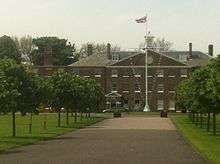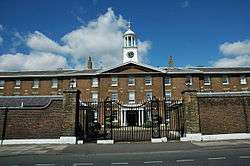Royal Marine Depot, Deal
Royal Marine Depot, Deal | |
|---|---|
| Deal, Kent | |
|
Admiralty Mews (formerly East Barracks) | |
 Royal Marine Depot, Deal Location within Kent | |
| Coordinates | 51°13′03″N 1°24′08″E / 51.2175°N 1.4022°ECoordinates: 51°13′03″N 1°24′08″E / 51.2175°N 1.4022°E |
| Type | Royal Marines Base |
| Site history | |
| Built | 1795 |
| Built for | War Office |
| In use | 1795-1996 |
| Garrison information | |
| Occupants | Royal Marines |
The Royal Marine Depot, Deal (also called the Royal Marine Depot, Walmer) was a military installation occupied by the Royal Marines and located at in South Deal on the road to Walmer.
History

The South barracks, which opened in 1795 shortly after the outbreak of the French Revolution, originally consisted of the officers' accommodation with clock and cupola flanked by separate infantry barracks and cavalry barracks. The buildings are said to be "one of the most complete late 18th century barracks in the country".[1] The 15th Light Dragoons were accommodated there from 1792 to 1815 - a convenient base during the Napoleonic wars. Part of the South barracks was used from 1815 as the quarters for the 'blockade men', drafted against a threat of local smuggling. The South barracks became a coastguard station thereafter, and this duty continued until 1840. Thereafter they accommodated various Line Infantry regiments until 1861 when the Royal Marines arrived. The barracks, which were converted to residential apartments in the early 21st century, are now known as the "Cavalry Barracks".[2]
The East barracks, which also opened in 1795, was originally a Naval hospital but had to be rebuilt in 1812 after the original structure was destroyed by lightning. The East barracks subsequently accommodated the Royal Marines School of Music which relocated there in 1930. The East barracks were converted into private housing in 1997 and are now known as "Admiralty Mews".[2]
The North barracks, which opened in 1797, was originally an Army hospital, one of the first military hospitals in the United Kingdom. Little survives today beyond a number of houses built to accommodate officers or surgeons. This area is now known as "The Churchills".[3]
The Infirmary barracks were built in 1900 on a former drill field; they closed in 1988 and the barracks were demolished to make way for a private housing development now known as "Marine Mews".[2]
On 29 October 1940, during the Second World War, the Royal Marines Depot was attacked from the air. The Battle of Britain campaign diary records: Army Stations 29 October 1940, Deal: At 1640 hours, three HE bombs were dropped in the barracks, the casualties being 1 Officer and 7 other ranks killed, 6 Officers and 6 other ranks wounded.[4]
At approximately 8:20 am on 22 September 1989, the Royal Marines School of Music was bombed by the IRA, resulting in the deaths of 11 bandsmen, and injuries to 22 other marines. A memorial garden, built in remembrance of the men that died, is situated in the grounds of the East barracks where the bomb went off.[5]
The depot was largely withdrawn from service in 1991 although the Royal Marines School of Music remained on site in the East barracks until 1996.[6] In 2005, the Old Gymnasium in the South barracks was renovated and it won the Building Renovation category in the Kent Design Awards.[7]
References
- ↑ "Building 129 (Guard House), South Barracks - Walmer - Kent - England - British Listed Buildings". britishlistedbuildings.co.uk. Retrieved 24 September 2015.
- 1 2 3 "WalmerWeb: Local History - The Royal Marines". walmerweb.co.uk. Retrieved 24 September 2015.
- ↑ "Building 68 and Attached Rear Wall, North Barracks - Walmer - Kent - England - British Listed Buildings". britishlistedbuildings.co.uk. Retrieved 24 September 2015.
- ↑ "The Battle Of Britain Home Page: Battle of Britain Campaign Diary. 29 October 1940". The Royal Air Force. Archived from the original on March 15, 2004. Retrieved 1 February 2010.
- ↑ "Concert recalls 11 killed by IRA". BBC News. 12 July 2009. Retrieved 29 August 2009.
- ↑ "Walmer and the Royal Marines". Walmer.web. Retrieved 22 May 2016.
- ↑ "Top design award for converted rail shed". www.kentonline.co.uk. 2 December 2005. Archived from the original on January 17, 2014. Retrieved 16 January 2014.
